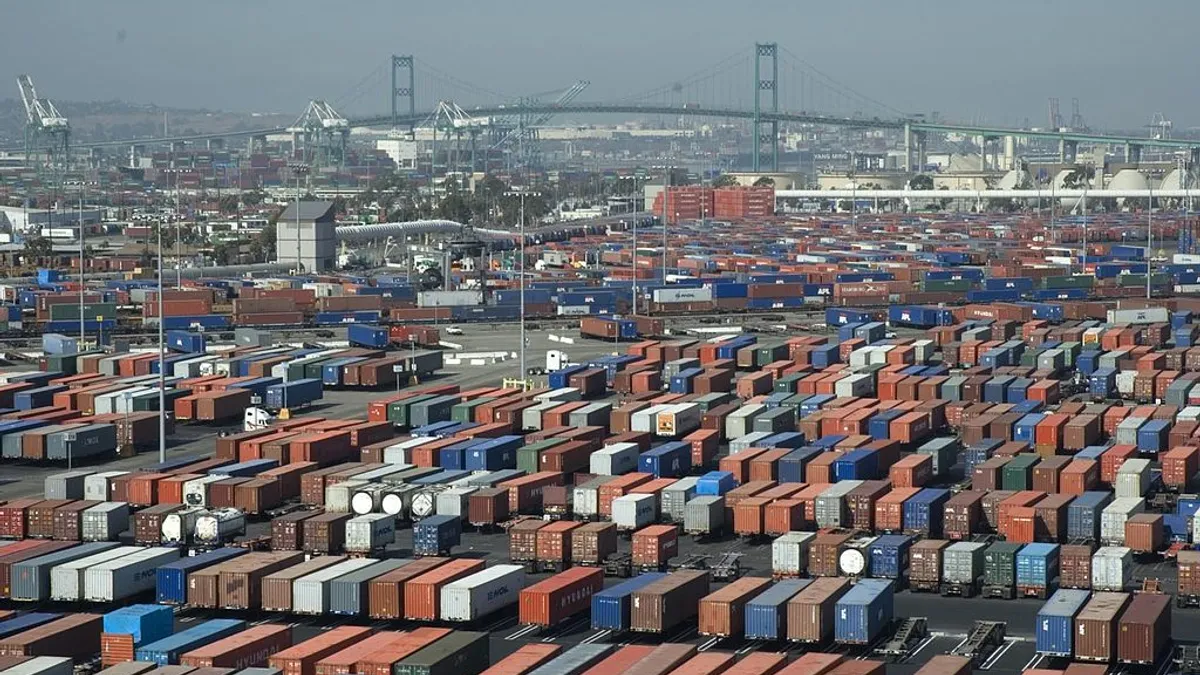Dive Brief:
- The four companies that operate The Port of Long Beach's six terminals have committed to raise the rate of dual transactions at their facilities to at least 50%, the port said in a press release.
- The port and the terminal operators are working with shippers and trucking operators to improve appointment systems in an attempt to increase the number of dual transactions, according to the port.
- Port of Long Beach Executive Director Mario Cordero said there is no timeline for achieving the 50% goal but said short-term results were important because of the current import surge. Increasing dual transactions "is a priority given the volumes we have witnessed here at the port," Cordero said.
Dive Insight:
Southern California ports for weeks have been inundated with import containers at levels well above last year. The volume has choked supply chains and left stakeholders to increase throughput.
"It's still very, very difficult to efficiently and fluidly move cargo through the gateway right now," said Weston LaBar, the CEO of the Harbor Trucking Association. LaBar and the HTA have been among the leaders calling for the increase in dual transactions.
Cordero said it will be up to the terminals to prioritize how they increase the number of dual transactions. When asked what percentage of the terminals' moves are currently dual transactions, Cordero declined to provide a specific number and said some terminals have a rate higher than 50% while others have a lower figure.
The Port of Los Angeles is also trying to increase its dual transactions. Port of Los Angeles Executive Director Gene Seroka said last month it would propose monetary incentives for dual transactions to the Los Angeles Board of Harbor Commissioners in the coming weeks. The proposal was not on the agenda at the Commissioners' Dec. 3 meeting. Cordero said The Port of Long Beach is not currently considering financial incentives but said it will continue to monitor its options as it works to address the volume surge.
LaBar said changes to the appointment systems are an important step in improving the rate of dual transactions and noted the HTA has worked with terminals on these efforts. Many of the issues at port facilities, including chassis and driver shortages, would be improved with increased dual transactions, he said.
Suggested changes to the appointment systems included getting rid of the requirement to make a separate appointment for an empty return for a trucker making a pickup appointment. Other changes could revolve around making user interfaces more intuitive, LaBar said.
"Why can't I just signify at that import appointment that I'm bringing an empty container with me?" LaBar said. "Those are the types of common sense things that we've asked folks to institute."
Cordero said a single appointment system to cover all of the terminals is "an ongoing conversation."
More clarity from ocean carriers on where empties will be dropped off along with terminals guaranteeing appointments would also aid in increasing dual transactions, LaBar said.
Cordero said the issue of appointments goes both ways. "Marine terminal operators maximize appointments, but on the other hand, the truckers meet those appointments," he said.
Ocean carriers have been involved in the discussions around the fluidity of cargo movement, Cordero said. But he and LaBar agreed the carrier's alliance structure has complicated container movement in ports. Before the alliances, one carrier would have containers at one terminal, but that is no longer the case, Cordero said.
LaBar said the HTA had met with three carriers but had not seen any changes to operations after making suggestions for how to improve cargo movement.
"The sad matter of the fact is for every efficiency that has been created on the water side for the ocean carriers because of the vessel sharing agreements and the alliance structures, we have seen an equal or greater amount of inefficiencies put on the back of the land-side stakeholders," LaBar said.















